Intel Broadwell Architecture Preview: A Glimpse into Core M
by Ryan Smith on August 11, 2014 12:01 PM ESTPutting It All Together: Low Power Core M
So far we’ve discussed Broadwell’s architecture on a broad basis, focusing on features and optimizations that are fundamental to the architecture. However to talk about the Broadwell architecture is not enough to fully explain the Core M itself. Though many of Core M’s improvements do come from Broadwell, Intel has also made a number of alterations to everything from the CPU packaging to the process node itself specifically for Core M. It’s the resulting combination of these factors that has allowed Intel to iterate on Broadwell-Y over Haswell-Y, and why Intel is so confident in Broadwell-Y’s capabilities and suitability for mobile form factors.
When it comes to building and configuring Core M, Intel likes to refer to their efforts as the “Fanless Challenge,” reflecting the fact that their biggest goal with Core M is to comfortably get the processor in to 10” tablets under 10mm in thickness that are passively cooled. A big part of getting into such a device is meeting the heat dissipation limitations of the form factor – a 10” tablet under 10mm would require a sub-5W SoC – which is where a lot of Intel’s engineering efforts have gone. Broadwell’s performance optimizations, the GPU optimizations, GPU duty cycling, and the 14nm process all contribute to getting a Core CPU’s power consumption down to that level.
But even that’s still not enough, and for Core M Intel went so far as to give Broadwell-Y its own die and design a low-power optimized version of their 14nm process just for it. This variant is designed to further reduce power consumption by optimizing the resulting transistors for lower power, lower voltage, lower clockspeed operation. By doing this Intel was able to further reduce power consumption in all of the major areas over what would be a traditional 14nm Intel process.
In the resulting 14nm Broadwell-Y process, voltage, capacitance, and leakage were all improved over the traditional 14nm process. Capacitance was reduced by 15%, minimum operating voltages by 10%, and leakage was improved to the point that it reduced SoC power consumption by 10%. The combination of all of these factors serves to significantly lower power consumption over what Intel’s traditional 14nm process would provide.
Working in concert with Broadwell-Y’s 14nm process, Intel has made a number of other changes to further reduce power consumption. Some of these are reflected in Broadwell’s overall design and others are unique to Broadwell-Y, such as using a lower TjMax for Broadwell-Y. By reducing the maximum operating temperature of the chip Intel has been able to realize further power savings by further reducing voltage and decreasing the maximum amount of temperature-dependent leakage the SoC will experience.
Meanwhile Broadwell-Y’s partner in crime, the on-package PCH, has received its own optimizations to reduce power consumption on the SoC’s total power consumption. The PCH itself is not much of a power hog in the first place – it’s still made on Intel’s 32nm process for this and cost reasons – but with such a strong focus on power consumption every watt ends up counting. As a result the Broadwell PCH-LP has seen optimizations that cut its idle power consumption by 25% and its active power consumption by 20%. Further improvements to the PCH’s monitoring hardware also mean it’s more responsive and can be controlled to a finer degree than the Haswell PCH-LP, and Intel has upgraded to a faster audio DSP to improve performance and reduce power consumption there as well.
Feeding all of that silicon in turn is Intel’s second generation Fully Integrated Voltage Regulator (FIVR), which further builds off of Intel’s other optimizations. The 2nd gen FIVR has been tuned for Broadwell-Y’s lower voltages, making the FIVR itself more efficient when delivering power at those voltages. To accomplish this Intel has implemented non-linear vDroop control, which is designed to better control the voltage when workload changes would cause voltage overshoots that waste power. And when even the 2nd gen FIVR isn’t efficient enough, this latest FIVR offers a second mode (LVR Mode) for low voltage/workload situations where the FIVR can be partially bypassed to reduce the FIVR’s power consumption.
Interestingly Broadwell-Y also sees the voltage regulation inductors redesigned and relocated in both the name of power efficiency and space efficiency. We’ll get to the case of space efficiency in a moment, but for power efficiency the new 3D inductors (3DLs) have been placed on the underside of the package, allowing the use of more efficient inductors that waste less power.
This brings us to the final element of Intel’s power optimization efforts, which involve further adjustments to turbo boost as part of Intel’s “hurry up and go to sleep” motto. New for Broadwell-Y is a 3rd power state, PL3, which allows for even greater turbo boosting, but for only a very limited period of time – on the order of milliseconds. PL3 represents the maximum amount of power the device battery can deliver, and while it’s okay to reach this value sparingly, PL3 is a fast drain that is very hard on the battery. The existence of PL3 in this case is as much for battery protection as it is for performance; it allows devices to tap into PL3 power levels on occasion, all the while allowing PL2 (the regular burst limit) to be defined at a safer value below the battery’s limit. Put another way, by knowing PL3 devices know how to stay farther away from it, which in the long run is what’s best for battery reliability.


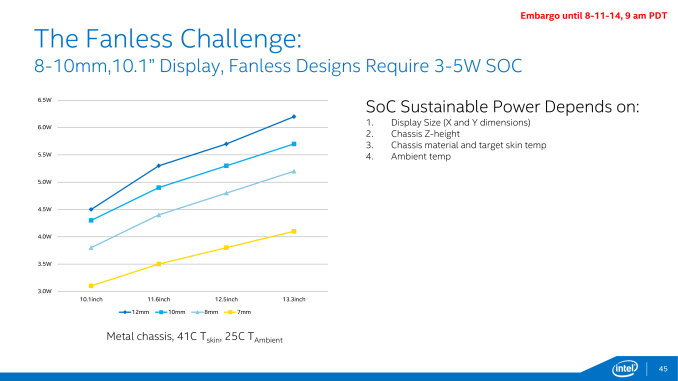
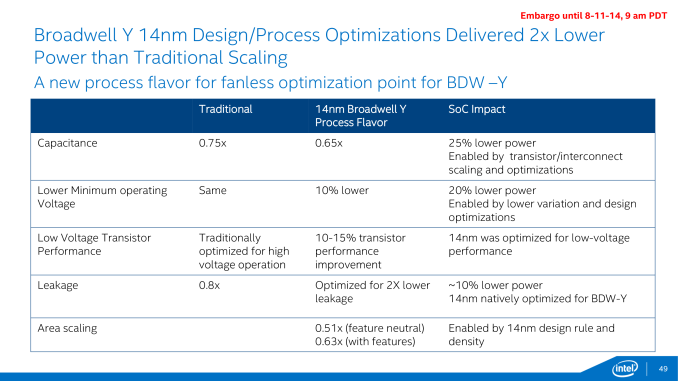
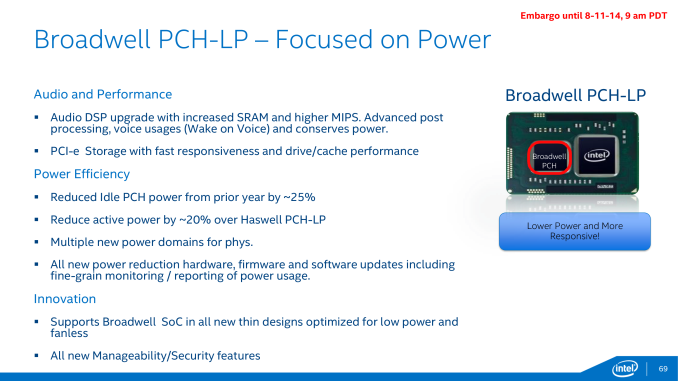
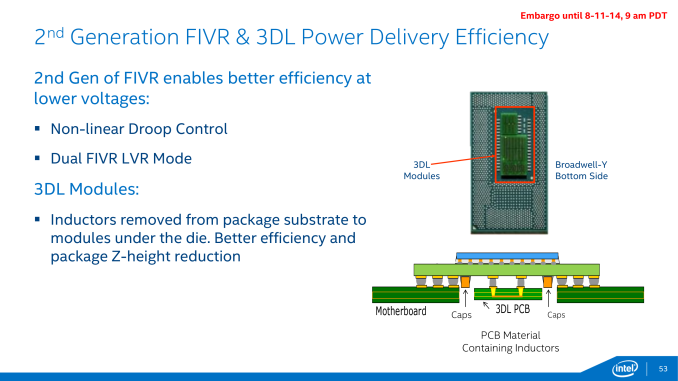

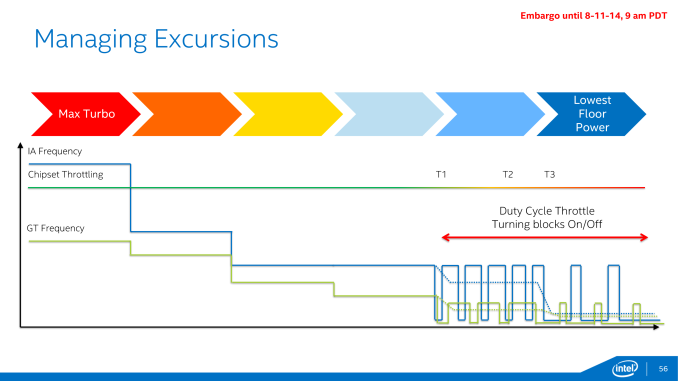








158 Comments
View All Comments
isa - Monday, August 11, 2014 - link
I appreciate the thoughts, but I'm actually an ASIC designer, so I have no problem with lingo - I just am not informed regarding my specific question. And my current laptop is a Penryn 2008 laptop, so forgive me if we ignore the need question and stay focused on what version(s) of Broadwell are intended for mainstream (non-gaming) desktop replacement laptops. thanks!ZeDestructor - Monday, August 11, 2014 - link
You want the full HQ/MQ series for your next laptop. Those are the full quad-core-enabled machines, which is something your probably want for a hi-performance machine. Since this is a gaming laptop though, you may want to look into building a small mini-ITX desktop though, they're comparable if your primary definition of "mobile gaming" is "drag computer to a LANparty/friend's place" rather than actually gaming on a train or similar.name99 - Tuesday, August 12, 2014 - link
If you can afford it, why are you dicking around with trying to save a few hundred dollars?If you want a serious machine, buy an rMBP with quadcore i7.
If you want a light machine, buy an MBA.
Then either stick Parallels on it (if you use OSX) or just run Boot Camp and never touch OSX, except maybe once every two months to update the firmware.
If you can afford it, life's too short to waste time trying to figure out which of fifty slightly different laptop PCs will suck less in their different hardware, different pre-installed crap-ware, different drivers. Just pay a little more and get something that most people consider works well.
ZeDestructor - Tuesday, August 12, 2014 - link
As an ASIC designer, OSX is just a non-option. Hell, even Linux is rather hairy compared to Windows for ASIC stuff.I personally like the Dell Precision line, but Lenovo Thinkpad W and HP Elitebook would also doo. In a pinch, a ridiculously-specced Compal (in it's various Sager rebrands) would also do, but IMO are just not built anywhere close.
Kjella - Monday, August 11, 2014 - link
Y = tabletsU = ultraportables
H = laptop/desktops
EP/EX = workstations/servers
So H. Out in Q2 2015, by current best guesses.
isa - Monday, August 11, 2014 - link
Thanks, Kjella. Upon further googling after reading your post, I learned that there apparently will be a mobile and deskop version of the H flavor, and it does look like the mobile H is the most likely for me. But that's not rumored to come out until May or June 2015, which is disappointing.Even weirder, since the first desktop version of Broadwell will be available in PCs in May/June 2015, and since the first version of Skylake (rumored to be a desktop version) is rumored to be "available" 2H 2015, it seems Broadwell H desktop is slated for a very, very short product life. Similarly, is Broadwell H mobile also slated for an extremely short product life?
Perhaps I missed it, but it would be great if there were an Anandtech chart comparing Intel's definitions of "announced", "launched", "samples", "volume shipments", "available", and similar Intelese to figure out about how many months from each it is till Joe Consumer can buy the chip in question. I suspect these definitions and even the lingo can vary with each tick and tock, but some kind of cheat sheet guestimates would be great (and revised as better info arrives, of course).
isa - Monday, August 11, 2014 - link
To further clarify the need for a cheat sheet, I'm familiar with the timing of tick and tock for the last few years, but it seems that 2014/2015 at a minimum will diverge so much from the last few years that previous expectations add confusion rather than clarity.ZeDestructor - Monday, August 11, 2014 - link
Judging by the delay for BW, Skylake will probably be pushed forward at least 6 months, if only to make up the R&D costs of BW. Then again, Intel wants that tablet market, so they might not either.IntelUser2000 - Wednesday, August 13, 2014 - link
"Similarly, is Broadwell H mobile also slated for an extremely short product life?"No its not. Companies like Intel cares about 5% profit differences, so having a short product life would make absolutely no sense. Broadwell isn't coming to "mainstream" desktops, only high-end enthusiast ones like the K series.
So they will all happily be a family like this:
-Skylake mainstream desktop
-Broadwell H/U/Y/K
name99 - Tuesday, August 12, 2014 - link
Semiaccurate says that quadcores (which I take to mean H-series) will not be out until 11 months from now.(Makes you wonder WTF has happened to the Skylake timeline. They haven't yet admitted that that has even slipped, let alone by how much.)